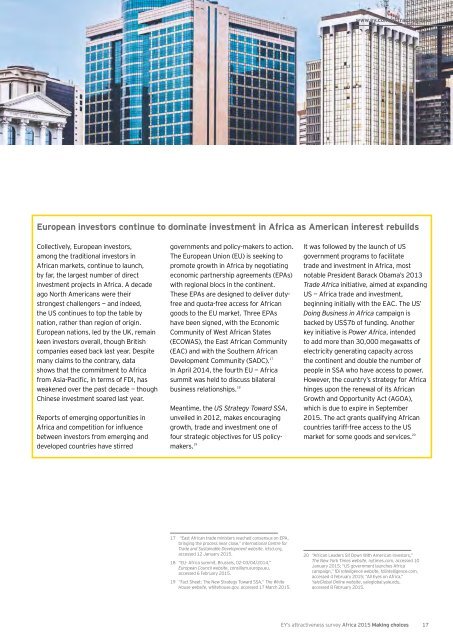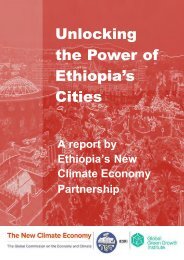EY-africa-attractiveness-survey-june-2015-final
EY-africa-attractiveness-survey-june-2015-final
EY-africa-attractiveness-survey-june-2015-final
You also want an ePaper? Increase the reach of your titles
YUMPU automatically turns print PDFs into web optimized ePapers that Google loves.
www.ey.com/<strong>attractiveness</strong>European investors continue to dominate investment in Africa as American interest rebuildsCollectively, European investors,among the traditional investors inAfrican markets, continue to launch,by far, the largest number of directinvestment projects in Africa. A decadeago North Americans were theirstrongest challengers — and indeed,the US continues to top the table bynation, rather than region of origin.European nations, led by the UK, remainkeen investors overall, though Britishcompanies eased back last year. Despitemany claims to the contrary, datashows that the commitment to Africafrom Asia-Pacific, in terms of FDI, hasweakened over the past decade — thoughChinese investment soared last year.Reports of emerging opportunities inAfrica and competition for influencebetween investors from emerging anddeveloped countries have stirredgovernments and policy-makers to action.The European Union (EU) is seeking topromote growth in Africa by negotiatingeconomic partnership agreements (EPAs)with regional blocs in the continent.These EPAs are designed to deliver dutyfreeand quota-free access for Africangoods to the EU market. Three EPAshave been signed, with the EconomicCommunity of West African States(ECOWAS), the East African Community(EAC) and with the Southern AfricanDevelopment Community (SADC). 17In April 2014, the fourth EU — Africasummit was held to discuss bilateralbusiness relationships. 18Meantime, the US Strategy Toward SSA,unveiled in 2012, makes encouraginggrowth, trade and investment one offour strategic objectives for US policymakers.19It was followed by the launch of USgovernment programs to facilitatetrade and investment in Africa, mostnotable President Barack Obama’s 2013Trade Africa initiative, aimed at expandingUS — Africa trade and investment,beginning initially with the EAC. The US’Doing Business in Africa campaign isbacked by US$7b of funding. Anotherkey initiative is Power Africa, intendedto add more than 30,000 megawatts ofelectricity generating capacity acrossthe continent and double the number ofpeople in SSA who have access to power.However, the country’s strategy for Africahinges upon the renewal of its AfricanGrowth and Opportunity Act (AGOA),which is due to expire in September<strong>2015</strong>. The act grants qualifying Africancountries tariff-free access to the USmarket for some goods and services. 2017 “East African trade ministers reached consensus on EPA,bringing the process near close,” International Centre forTrade and Sustainable Development website, ictsd.org,accessed 12 January <strong>2015</strong>.18 “EU- Africa summit, Brussels, 02-03/04/2014,”European Council website, consilium.europa.eu,accessed 6 February <strong>2015</strong>.19 “Fact Sheet: The New Strategy Toward SSA,” The WhiteHouse website, whitehouse.gov, accessed 17 March <strong>2015</strong>.20 “African Leaders Sit Down With American Investors,”The New York Times website, nytimes.com, accessed 10January <strong>2015</strong>; “US government launches Africacampaign,” fDi Intelligence website, fdiintelligence.com,accessed 4 February <strong>2015</strong>; “All Eyes on Africa,”YaleGlobal Online website, yaleglobal.yale.edu,accessed 8 February <strong>2015</strong>.<strong>EY</strong>’s <strong>attractiveness</strong> <strong>survey</strong> Africa <strong>2015</strong> Making choices17



